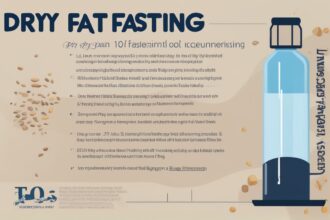Hey there, fellow health enthusiasts! If you’ve been exploring the world of fasting, you’ve likely stumbled across the concept of dry fasting—a practice that’s gaining attention for its potential health benefits but also comes with some serious considerations. Unlike water fasting, where hydration is still on the table, dry fasting takes things to the next level by abstaining from both food and water for a set period. It’s intense, it’s not for everyone, and it requires strict adherence to dry fasting guidelines to stay safe. In this comprehensive guide, I’ll walk you through what dry fasting is, its purported benefits, the risks involved, and practical steps to approach it responsibly. Whether you’re curious or considering giving it a try, let’s dive into the science, safety protocols, and real-world tips to make sense of this unique fasting method.
What Is Dry Fasting and How Does It Work?
Dry fasting is a form of intermittent fasting where you refrain from consuming any food or liquids, including water, for a specific duration. This practice has roots in various cultural and religious traditions, such as Ramadan in Islam, where participants often fast without water during daylight hours. The idea behind dry fasting is to push the body into a deeper state of ketosis and autophagy—a cellular cleanup process—faster than other fasting methods. When you withhold water, the body is forced to rely on its internal reserves, including metabolic water produced from fat stores, to stay hydrated (Filonov, 2019). While this might sound extreme, proponents claim it can amplify detoxification and weight loss. However, without proper dry fasting guidelines, this method can quickly become dangerous, leading to dehydration or electrolyte imbalances. So, understanding the mechanics and limits of your body is key before even thinking about starting.
Potential Benefits of Dry Fasting
Why would anyone willingly skip water, you ask? Well, some intriguing benefits have been associated with dry fasting, though the research is still emerging. First off, it’s believed to accelerate fat loss by forcing the body to tap into fat reserves for both energy and hydration. A small study suggested that dry fasting could enhance metabolic flexibility, allowing the body to switch more efficiently between energy sources (Smith et al., 2020). Additionally, dry fasting may promote autophagy at a faster rate than water fasting, as the stress of dehydration signals cells to recycle damaged components more aggressively (Levine & Kroemer, 2019). Some anecdotal reports also mention improved mental clarity and reduced inflammation, though these claims need more robust scientific backing. That said, following strict dry fasting guidelines ensures you don’t overdo it and can potentially reap these rewards. Let’s break down a few key benefits often discussed in the fasting community:
- Faster Ketosis: Without water or food, the body may enter ketosis more rapidly, burning fat for fuel.
- Cellular Repair: Enhanced autophagy could help clear out damaged cells, potentially slowing aging processes.
- Detoxification: Proponents claim it supports the body’s natural detox pathways, though evidence is limited.
- Mental Focus: Some report heightened clarity, possibly due to ketone production affecting brain function.
Risks and Challenges of Dry Fasting
Let’s be real—dry fasting isn’t a walk in the park, and it’s definitely not for beginners. The most obvious risk is dehydration, which can lead to symptoms like dizziness, fatigue, and even kidney stress if prolonged (World Health Organization, 2021). Electrolyte imbalances are another concern, as you’re not replenishing essential minerals like sodium and potassium through fluids. Plus, without proper dry fasting guidelines, you might push your body too far, risking headaches, irritability, or worse—organ strain. This method can be particularly dangerous for individuals with pre-existing conditions like diabetes or heart issues, as the body’s stress response is heightened. I can’t stress enough how important it is to approach this with caution and ideally under medical supervision. Here are some common risks to keep in mind:
- Dehydration: Lack of water intake can cause severe dehydration, especially in hot climates or during physical exertion.
- Electrolyte Loss: Without fluids, maintaining sodium and potassium levels becomes challenging, risking cramps or worse.
- Fatigue and Dizziness: Low hydration often leads to energy crashes and lightheadedness.
- Kidney Stress: Prolonged dry fasting may strain kidneys due to concentrated urine and reduced fluid volume.
- Mood Swings: Hunger and dehydration can make you irritable or anxious, affecting mental well-being.
Dry Fasting Guidelines for Safe Practice
Alright, if you’re still curious about trying dry fasting, let’s talk about how to do it safely. The golden rule? Start small and listen to your body. Dry fasting guidelines are all about minimizing risks while testing the waters (pun intended). For beginners, limit your first dry fast to 12–16 hours—think overnight to mid-morning. This mimics natural sleep cycles when you’re not drinking anyway. Make sure you’re well-hydrated in the days leading up to the fast, as starting with a hydration deficit is a recipe for disaster. Also, avoid intense physical activity during the fast; your body is already under stress. Break your fast gently with small sips of water before reintroducing food to avoid shocking your system. And please, if you feel unwell at any point—stop. Safety over everything. Always consult a healthcare provider, especially if you’re on medication or have health conditions. These dry fasting tips are your foundation for a cautious approach.
Who Should Avoid Dry Fasting?
Not everyone is a candidate for dry fasting, no matter how strict the dry fasting guidelines are. If you’re pregnant, breastfeeding, or under 18, this practice is a hard no—your body needs consistent hydration and nutrients for growth and recovery. People with chronic illnesses like diabetes, kidney disease, or heart conditions should also steer clear, as the stress of dehydration can exacerbate these issues (World Health Organization, 2021). Even if you’re healthy, dry fasting isn’t something to jump into without preparation or after a lifetime of poor hydration habits. I’ve seen folks in fasting forums dive in headfirst without considering their baseline health, and it often ends in a rough experience. If you’re unsure, a quick chat with your doctor can save you a lot of trouble. Remember, fasting—especially dry fasting—should enhance your health, not jeopardize it.
How to Prepare and Recover from a Dry Fast
Preparation and recovery are just as important as the fast itself when following dry fasting guidelines. Before you start, spend at least 2–3 days hydrating like it’s your job—aim for 2–3 liters of water daily, and include electrolyte-rich foods like bananas or coconut water. Eat light, nutrient-dense meals to stock up on energy without overloading your digestive system. During the fast, rest as much as possible and stay in a cool, comfortable environment to minimize sweat loss. When it’s time to break the fast, don’t chug a gallon of water or dive into a heavy meal. Start with small sips of room-temperature water, wait 30 minutes, then introduce a light broth or fruit like watermelon to ease your body back into hydration and digestion. Recovery can take a day or two, so don’t rush back into intense workouts or heavy eating. Following these dry fasting tips can make the transition smoother and safer for your system.
As we wrap up, I want to emphasize that dry fasting is a powerful but challenging tool in the wellness toolkit. It’s not a one-size-fits-all solution, and adhering to dry fasting guidelines is non-negotiable if you’re considering it. The potential benefits—like faster fat loss or enhanced autophagy—are exciting, but they come with real risks like dehydration and electrolyte imbalances. My advice? Approach it with curiosity but also caution. Start slow, prioritize safety, and never hesitate to seek professional guidance. Fasting should feel empowering, not punishing. Have you tried dry fasting, or are you just dipping your toes into fasting practices? Drop your thoughts or questions below—I’d love to hear your journey and keep this conversation going!
References
- Filonov, S. (2019). Dry fasting: Guide to miracle of fasting. Independently Published.
- Levine, B., & Kroemer, G. (2019). Biological functions of autophagy genes: A disease perspective. Cell, 176(1-2), 11-42. https://doi.org/10.1016/j.cell.2018.09.048
- Smith, A. P., et al. (2020). Metabolic effects of intermittent fasting methods. Journal of Nutritional Science, 9, e12. https://doi.org/10.1017/jns.2020.5
- World Health Organization. (2021). Dehydration and health: Global burden and prevention strategies. WHO Press.






